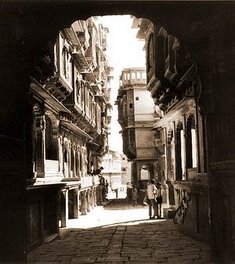Crowds in India are especially fast-paced and hectic. Everyone is on a perpetual chase, desperately afraid of losing something: their luggage, their place in line, or the rickshaw at the head of the pack. Indians that I've talked to cite the unstable political climate during the last century as a cause for insecurity and lack of trust -"an every man for themself" mentality. I've noticed this feeling of unease every where that I've been: A person's facial expression will say "everything that I own may be swept away at any moment." A few weeks ago, I was sick at the hospital and remember the flood of people at the receptionist's desk, arms were raised carrying papers to be turned in. I remember standing in a crowd of patients that opened the side door and entered behind the counter to bypass the lines outside. The clerks were powerless and could only type so fast. After security guards managed to get them out, more waves of people lapped up against the closed door.
This is partly what made the Golden Temple in Amritsar so unique. After checking shoes at the counter, everyone peacefully and patiently waited to reach the communal sinks to wash hands and feet. Crowds of people from all religions conducted rituals, sang, and conversed. These were meditative crowds, emananating spirituality that seemed eerie in contrast to the city outside.
I entered the temple and met an old man who took it upon himself to guide me through the complex. He only knew a few English words but our combined efforts at foreign languages were sufficient for understanding each other. Walking up and down the floors I was frequently stepping over people who were deep in their own worlds. I was taught where and how to pray and to kneel, given a brief history of the temple, its structures made of pure gold, the Ten Gurus, and constantly reassured with hands placed on my shoulder, "all are welcome."
Lunch in the communal kitchen was an incredible experience. The staff is made of volunteers, anyone can take part at any station, cooking or cleaning. The amount of food far exceeded the demand, despite the seemingly countless rows of people. We all stared and wondered at each other as we ate, mutually sharing the alien yet welcoming feeling in the atmosphere.
We visited the Temple three times: in the Evening before dinner, at 10:30pm and at 4:00am to watch the closing and opening processions. Posted is also a picture of Jallianwalah Bagh, the site of General Dyer's 1919 Massacre.

One of four entrances to the Golden Temple.

The Golden Temple

At Night.

The Jallianwalah Bagh Massacre Monument.

Amritsar










